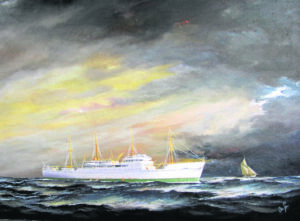Business & Education
It was 103 years ago that the Selandia first sailed away
This article is more than 10 years old.
February, 2012 marked the centenary of the maiden voyage of the world’s first diesel-powered ocean liner, from Copenhagen’s B&W shipyard to Bangkok

Thirty years into its lifespan, the Selandia sunk off the coast of Japan, but still, 73 years later, its memory is celebrated (photo: www.snesejler.dk)
She was the pride of Denmark’s East Asiatic Company (EAC), built by the Burmeister & Wain (B&W) shipyard in Denmark, and was the first diesel-powered ocean liner to become seaworthy in a scramble that had been on since Dr Rudolf Diesel’s patent on his engine expired in 1910.
The race to be the first to launch a large-scale ocean liner with a motor engine could have been won by a number of contenders, but the M/S Selandia pipped them all to the post in February 1912.
The Selandia was known as ‘the ship without a funnel’: unlike steamships, the engine exhaust went through the foremast. It was a combined passenger and cargo vessel with 20 luxuriously spacious (at least for the time) first-class cabins that included toilets, baths and even servants’ quarters.
The world’s first motor ship
At 370ft (112m) long and 53ft (16m) wide, the Selandia was a giant of a vessel. But it was not her size nor her quarters that made her unique, but rather her two eight-cylinder, four-stroke, 1,250hp diesel engines, designed with both crossheads and piston rods, which gave the vessel a service speed of 11 knots (about 20 km/h).
The Selandia was not the first diesel-powered ship, but it was the first to make diesel engines seem an economically-viable alternative to the old coal-fired engines. Officially, it earned the title of being ‘the world’s first motor ship’ as the first one built for ocean travel using a propulsion plant.
A report at the time of Selandia’s sea trials said “the future of the big motor ship is practically assured.”
And with it, so was B&W’s economic future. Following the official acceptance tests of the Selandia, the Danish shipyard was inundated with orders from steamship owners for similar ships, and the company reported in 1912 that it had enough marine oil ship contracts for three years’ work.
Diesel pioneer
With the Selandia, the EAC became the first operator of diesel engine-powered vessels between international destinations. The ocean liner ushered in the era of diesel, and made the old coal-burning steam ships out-of-date almost overnight. Switching to diesel was preferable in every way: environmentally, operationally and – most importantly for companies like the EAC – economically.
The EAC’s order of the Selandia was a much bigger risk for the shipping firm than it might first seem. The vessel’s revolutionary propulsion plant was by-and-large untried, and it was not assured that it would work on such a long journey. Because of this risk, the contract between B&W and the EAC included a clause stating that the diesel engines should be replaced by steam engines if they did not work satisfactorily – a clause that proved unnecessary.
The Selandia’s pioneering propulsion engine would be the first of many. In a matter of months, other shipyards across the world were making similar large diesel engines, including MAN, Sulzer Bros, Krupp Germania Yards, Vickers Sons & Maxim, and Carels Freres.
For more than 20 years, the Selandia continued to generate interest all over the world. Her fans included an impressed Winston Churchill, at that time the British minister of naval affairs, who ordered a study to find out whether the engines could be used as propulsion plants for naval vessels. Her route, between Scandinavia, Italy and Thailand, opened an export corridor to the Far East and started the Danish service line.
Sunk off Japan
The Selandia remained in service for the EAC until November 1936, when she was sold to a Norwegian firm and renamed ‘the Norseman’. Four years later she was sold again, this time to the Finland-America line and renamed ‘The Tornator’. Somehow she ended up being sent to a Japanese firm, sailing in Japanese waters under the Japanese flag during the Second World War, though still with a Finnish crew.
On 26 January 1942, 30 years to the day after her first trial sailing, the Tornator, formerly the Selandia, struck a rock near Yokohama in bad weather, broke into two pieces and sank. All the crew were rescued without loss of life.
In conjunction with the centenary of the Selandia’s maiden voyage in 2012, a number of events were been planned, including a special exhibition at the Diesel House industrial museum in Copenhagen and the release of a documentary, ‘The Ship that Changed the World – M/S Selandia’ and a book.
At the centre of the exhibition, and towering above the rest of the fascinating photographs and travel accounts from the ship’s crew members, was one of the Selandia’s 12-metre tall diesel engines.










































